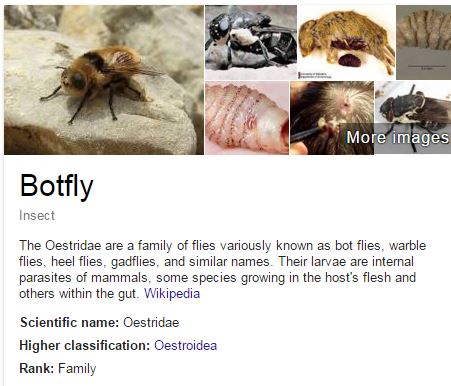 In the fall, in the Northern Hemisphere, whitish-yellow flecks commonly appear on the chest, belly and upper front limbs of horses. These flecks are eggs laid by the Bot Fly, a bee-like insect whose life cycle requires the horse as a host. These eggs contain a substance irritating to the skin, and horses often bite at them.
In the fall, in the Northern Hemisphere, whitish-yellow flecks commonly appear on the chest, belly and upper front limbs of horses. These flecks are eggs laid by the Bot Fly, a bee-like insect whose life cycle requires the horse as a host. These eggs contain a substance irritating to the skin, and horses often bite at them.
When swallowed, the larvae attach to and live on the lining of a horse’s stomach. Vets often see these larvae when performing endoscopy on horses for stomach ulcers. They are orange to red grubs about 3cm in length.
Bot flies themselves are common and can be highly annoying, sometimes causing horses to stampede but they are not harmful otherwise. You will see them repeatedly depositing their eggs on the skin with their long ovipositor.
WHAT TO DO
Recognize that bots generally do not cause horses much harm and so it is not necessary to completely eliminate them. The eggs are difficult to remove but can be scraped off with a specially shaped bot egg knife or combed out to reduce the number a horse ingests. Soaking the affected hair in hot water may help to loosen the eggs.
In late fall, after a few hard freezes the adult bot fly is inactive. This is a good time to try to remove the eggs. Talk to your vet about the necessity to de-worm your horse in the winter with ivermectin or moxidectin to kill the larval stages in your horse’s stomach. Talk to your vet if you have any additional questions or concerns.
WHAT YOUR VET DOES
Your vet considers bot management as part of a good general parasite control program.
http://horsesidevetguide.com/drv/Observation/57/bot-eggs-yellow-white-flecks-on-hair-or-skin/
Remove Bot Fly Eggs
Bot flies lay sticky pale yellow eggs on horse’s hair, usually on the forearms belly and chest. Adult bot flies lay their eggs on horses in the fall in the northern hemisphere. The flies do this instinctively.
A basic part of the bot’s life cycle requires that the horse bite at and swallow the eggs. The eggs hatch into larvae that over-winter attached to the lining of the horse’s stomach.
Bots are not thought to be very harmful to horses unless they infest a horse in high numbers. However, bot eggs that pepper the hair coat is aesthetically undesirable.
In late fall and winter moxidectin and ivermectin dewormer treatments kill bot larvae in the stomach, an important means of control. However, it is preferable to remove bot eggs before they are ingested, to reduce the number of larvae in the stomach.
PROCEDURE
Bot eggs are notoriously difficult to remove. They are extremely sticky and adhere well to the hair.
I recommend removing bot eggs in two steps. First, use hot water and a sponge to loosen the eggs. Then use a bot knife to scrape them off. A bot knife has a rounded, serrated edge. When it is firmly run down the limb, it scrapes off the bot eggs.
